

Compact Muon Solenoid
LHC, CERN
| CMS-PAS-HIN-15-001 | ||
| Nuclear modification of $\Upsilon$ states in PbPb | ||
| CMS Collaboration | ||
| June 2015 | ||
| Abstract: Yields of $\Upsilon$(1S), $\Upsilon$(2S) and $\Upsilon$(3S) mesons are measured in the CMS experiment via their $\mu^+ \mu^-$ decays, for bottomonium rapidity $|y|<$ 2.4, in PbPb and pp collisions at the same energy, $\sqrt{s_{\mathrm{ NN}}} =$ 2.76 TeV. The CMS detector was used to collect integrated luminosity of 166 $\mu$b$^{-1}$ for PbPb and 5.4 pb$^{-1}$ for pp, corresponding to a similar total number of nucleon-nucleon collisions. Differential cross sections and nuclear modification factors are reported as functions of rapidity and transverse momentum, as well as collision centrality, for the $\Upsilon$(1S) and the $\Upsilon$(2S). By comparing to the yield in pp collisions scaled by the number of inelastic nucleon-nucleon collisions, a strong, centrality-dependent suppression is observed in PbPb collisions, by up to a factor of 2 and 10, for the $\Upsilon$(1S) and the $\Upsilon$(2S), respectively. No significant dependences are observed as functions of rapidity or transverse momentum. The $\Upsilon$(3S) was not observed in PbPb collisions, being suppressed by more than 7 at the 95% confidence level. | ||
|
Links:
CDS record (PDF) ;
Public twiki page ;
CADI line (restricted) ; Figures are also available from the CDS record. These preliminary results are superseded in this paper, PLB 770 (2017) 357. The superseded preliminary plots can be found here. |
||
| Figures | |
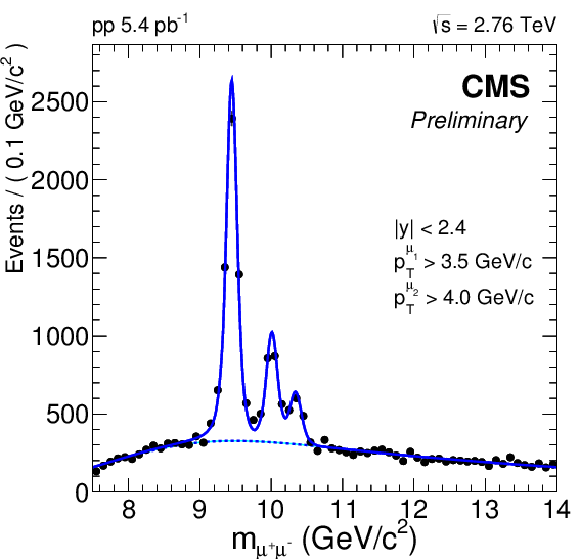
png ; pdf |
Figure 1-a:
Dimuon invariant mass distributions from the pp (a) and PbPb (b) data at $ {\sqrt {s_{_{\text {NN}}}}} = $ 2.76 TeV, for muon pairs having one $ {p_{\mathrm {T}}} $ greater than 4 GeV/$c$ and the other greater than 3.5 GeV/$c$. The solid (signal + background) and dashed (background only) lines show the result of fits described in the text. |
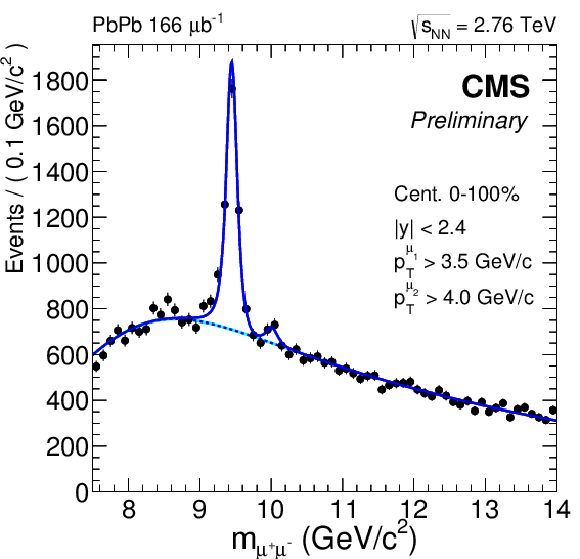
png ; pdf |
Figure 1-b:
Dimuon invariant mass distributions from the pp (a) and PbPb (b) data at $ {\sqrt {s_{_{\text {NN}}}}} = $ 2.76 TeV, for muon pairs having one $ {p_{\mathrm {T}}} $ greater than 4 GeV/$c$ and the other greater than 3.5 GeV/$c$. The solid (signal + background) and dashed (background only) lines show the result of fits described in the text. |

png ; pdf |
Figure 2-a:
Differential cross section of $ {\Upsilon }$ states as a function of their transverse momentum in pp (a) and PbPb (b) collisions. From top to bottom, squares, circles and triangles stand for $ {\Upsilon \mathrm {(1S)}}$, $ {\Upsilon \mathrm {(2S)}}$ and ${\Upsilon \mathrm {(3S)}}$, respectively. Statistical (systematic) uncertainties are displayed as error bars (boxes). Global uncertainties of 5% (a) and 10.5% (b) are not displayed. |
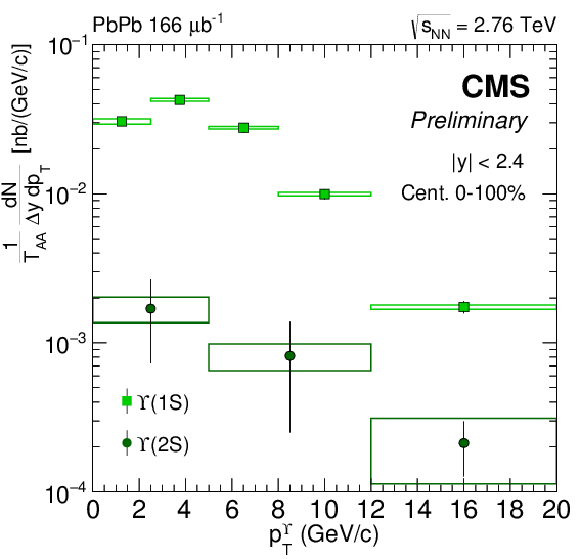
png ; pdf |
Figure 2-b:
Differential cross section of $ {\Upsilon }$ states as a function of their transverse momentum in pp (a) and PbPb (b) collisions. From top to bottom, squares, circles and triangles stand for $ {\Upsilon \mathrm {(1S)}}$, $ {\Upsilon \mathrm {(2S)}}$ and ${\Upsilon \mathrm {(3S)}}$, respectively. Statistical (systematic) uncertainties are displayed as error bars (boxes). Global uncertainties of 5% (a) and 10.5% (b) are not displayed. |
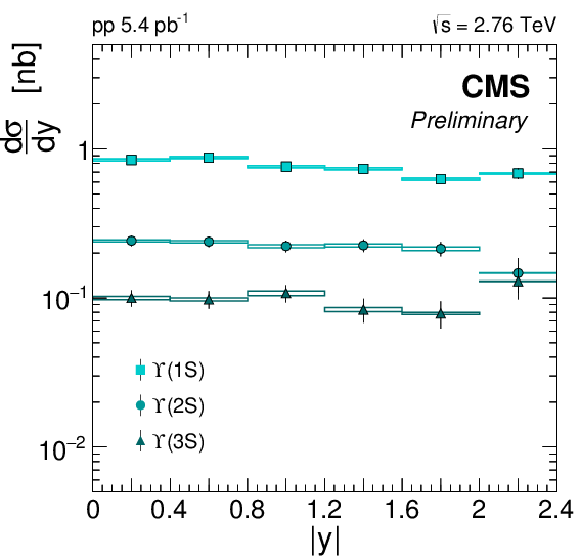
png ; pdf |
Figure 3-a:
Differential cross section of $ {\Upsilon }$ states as a function of their rapidity in pp (a) and PbPb (b) collisions. From top to bottom, squares, circles and triangles stand for ${\Upsilon \mathrm {(1S)}}$, $ {\Upsilon \mathrm {(2S)}}$ and $ {\Upsilon \mathrm {(3S)}}$, respectively. Statistical (systematic) uncertainties are displayed as error bars (boxes). Global uncertainties of 5% (a) and 10.5%(b) are not displayed. |
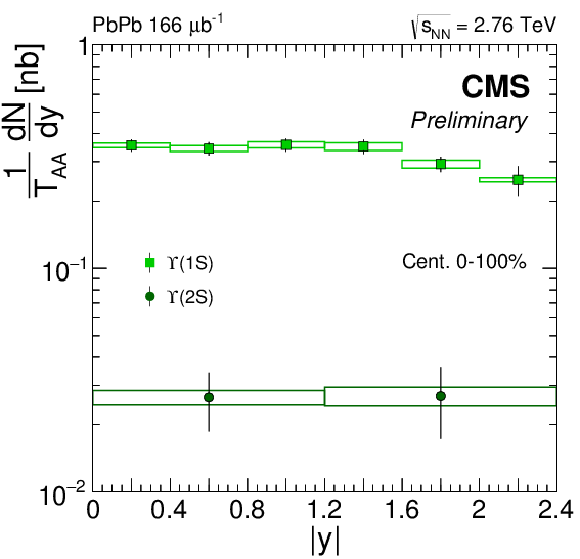
png ; pdf |
Figure 3-b:
Differential cross section of $ {\Upsilon }$ states as a function of their rapidity in pp (a) and PbPb (b) collisions. From top to bottom, squares, circles and triangles stand for ${\Upsilon \mathrm {(1S)}}$, $ {\Upsilon \mathrm {(2S)}}$ and $ {\Upsilon \mathrm {(3S)}}$, respectively. Statistical (systematic) uncertainties are displayed as error bars (boxes). Global uncertainties of 5% (a) and 10.5%(b) are not displayed. |

png ; pdf |
Figure 4-a:
Nuclear modification factor of $ {\Upsilon \mathrm {(1S)}}$ and $ {\Upsilon \mathrm {(2S)}}$ in PbPb collisions as a function of transverse momentum (a) and rapidity (b). Statistical (systematic) uncertainties are displayed as error bars (boxes), while the global fully-correlated uncertainty is displayed as a box at unity. |

png ; pdf |
Figure 4-b:
Nuclear modification factor of $ {\Upsilon \mathrm {(1S)}}$ and $ {\Upsilon \mathrm {(2S)}}$ in PbPb collisions as a function of transverse momentum (a) and rapidity (b). Statistical (systematic) uncertainties are displayed as error bars (boxes), while the global fully-correlated uncertainty is displayed as a box at unity. |

png ; pdf |
Figure 5:
Nuclear modification factor of $ {\Upsilon \mathrm {(1S)}}$ and $ {\Upsilon \mathrm {(2S)}}$ in PbPb as a function of centrality, displayed as the number of participating nucleons. Statistical (systematic) uncertainties are displayed as error bars (boxes), while the global fully-correlated uncertainty is displayed as a box at unity. |

|
Compact Muon Solenoid LHC, CERN |

|

|

|

|

|

|